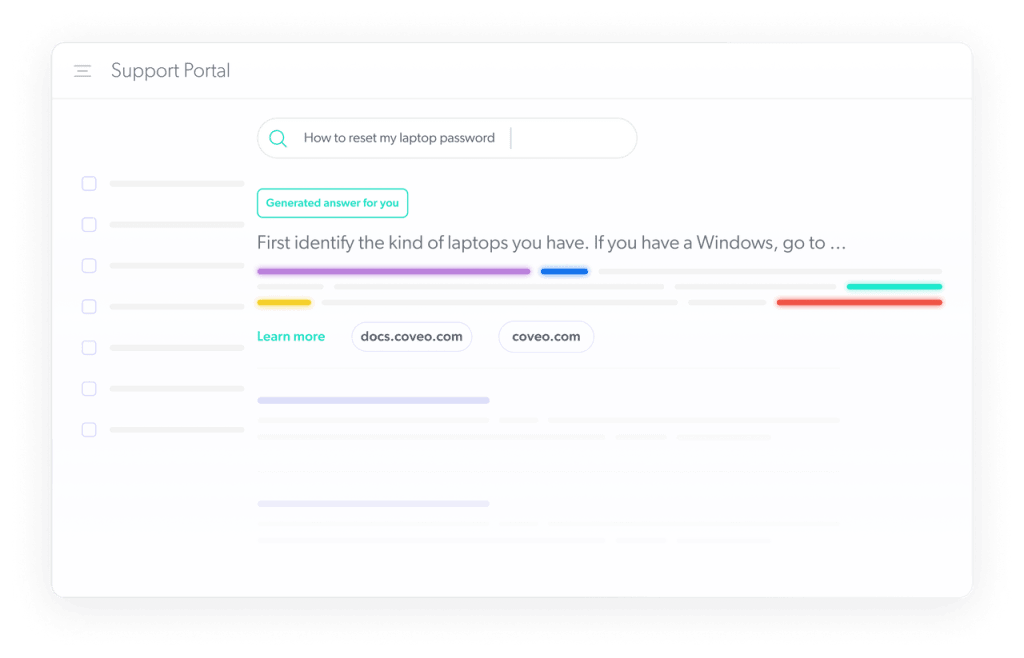When it comes to creating a good workplace experience for your employees, equipping them with the information they need is essential. But this is often easier said than done. According to Upwork, 22% of U.S. workers will be fully remote by 2025. And, according to Pew, over 20 million employed adults currently work from home 100% of the time. Hybrid work is also on the rise, with nearly 60% of white-collar workers saying they prefer working from home at least three days a week.
The prevalence of decentralized workplaces and hybrid/work-from-home arrangements combined with the changing needs (and demographics) of today’s workforce are part of what makes it difficult to create a seamless digital workplace experience.
Data from our most recent Workplace Relevance Report revealed that information overload is a growing problem – especially for frontline workers and younger, Gen Z employees. AI-powered technologies like intelligent search, conversational chatbots, and predictive AI that generates insights from reams of data are increasingly being used to create better workplace experiences.
In this post, we focus on how AI is being used in the workplace today for employee retention and how this translates to organizational success. We also cover some best practices for crafting effective AI-driven employee retention strategies that reduce employee turnover and increase your employee retention rate.
AI in the Workplace
First, let’s explore some tangible ways that AI is being leveraged by businesses to improve efficiency, productivity, and the overall employee experience.
Streamlined operations
AI, particularly GenAI, excels at automating repetitive tasks, reducing errors, and summarizing huge amounts of data in a way that’s digestible and easy for human brains to process. An intelligent search platform like Coveo uses powerful ML algorithms to connect users to relevant information across your entire knowledge base. Access to information is only half the battle when it comes to enabling employees to do their jobs. The other half is quickly finding that information in the moment of need, especially across a growing number of data repositories and touchpoints.

AI helps bridge this information gap by helping employees more efficiently search for and retrieve information. For example, Coveo’s intelligent search suite employs AI models like query suggestions and content recommendations to better understand employee needs, personalize interactions, and optimize information retrieval across multiple digital platforms and tools.
Enhanced Training Development
AI is also transforming the way companies approach employee learning with tools that personalize learning curriculums, incorporating real-time performance tracking, and employing elements like gamification and interactive quizzes that keep employees motivated and interested.
Microlearning, which delivers information in small, digestible chunks, is another effective approach that often uses AI to deliver relevant content to individuals on mobile devices. Microlearning caters to shorter attention spans and busy schedules, meeting employees where they are in the moment (often on their mobile devices).
Enhanced Communication and Collaboration
AI-driven language processing has enormous potential to revolutionize communication in the workplace, particularly for global teams. Though still imperfect, the technology can translate conversations in real-time. This technology has obvious implications for people communicating across countries and regions. It also makes information more accessible to hearing impaired individuals or those with cognitive differences since it helps to summarize and translate speech, turning it into searchable text.
AI-enhanced transcription tools already make it possible to easily record and transcribe real-time conversations. Tools like Otter.ai transcribe calls and events, recognize speech patterns, and interpret words even when speech is heavily accented. This makes collaboration much easier and helps people who may have language or hearing barriers more fully participate in meetings and events.
Streamlined Task Management
Workplace overwhelm is a top trend that we saw in our 2024 Major Workplace Trends roundup. Maintaining a good work life balance is the best way to reduce burnout and overwhelm – and improve job satisfaction. To this end, AI can help mitigate employee burnout (and improve turnover rate) by taking on some of the cognitive load that comes with performing repetitive and time-consuming tasks. It prepares new employees with the knowledge needed to tackle the challenges of an information-rich work environment.
This is particularly prevalent for marketing and customer service use cases. For example, marketing teams can use GenAI to scope campaigns, generate messaging ideas and content for social media posts, and automate testing and optimization of messaging and campaigns.
Enhanced Customer Service
Customer service teams are also using AI to streamline the case submission process, improve customer self service, and make knowledge more accessible to customer support teams.
For example, a new hire in customer service can more easily find and connect with experienced employees to resolve issues more quickly with AI-powered tools like Coveo’s Insight Panel. The Insight Panel self-optimizes search results, giving agents case-contextual recommendations that reduce the time it takes to get the right information. Call centers are also using AI to intelligently route customer issues to the correct human agent, enabling teams to resolve customer issues much more quickly.
Understanding Employee Retention
Employee retention is an organization’s ability to keep its employees and reduce turnover. A positive culture with open communication, collaboration, and recognition increases employee engagement and loyalty, all of which directly impact retention.
Providing clear paths for advancement, skill development, and fostering a culture of learning all work together to reduce voluntary turnover. So does paying attention to what’s not working. Getting employee feedback and building employee recognition into your approach are important. Rewards, raises, and advancement raise employee morale and show people that you’re invested in their growth. It allows every worker to develop skills and advance in their career. It also gives you an opportunity to celebrate employee development.
The key takeaway here is that employee retention is linked to opportunity. Career progression is the top reason employees start hunting for a new job, with only 59% of employees surveyed by McKinsey saying they felt supported in achieving their personal and professional development goals.
Money is no small matter either. Competitive compensation and robust employee benefits (health insurance, wellness program, retirement plan, paid leave, etc.) play a big role in employees’ decisions to join and remain with an employer. Work life balance is also important. Flexible work arrangements, reasonable workloads and schedules, and ample paid time off improve employee satisfaction and retention.
AI plays a role as part of a multifaceted employee retention approach because it helps organizations foster the engaging supportive environment that encourages valued employees to stick around.
AI-Powered Employee Retention Strategies
AI is helpful to HR leaders and employees alike. There are some tangible AI-powered retention strategies that you can put into play right now. Here are our favorites, including a few use cases from Coveo’s success archives:
- Personalized career development: Using AI to analyze employee skills, interests, and aspirations makes it possible to recommend tailored training programs and growth opportunities, plus it’s scalable. AI makes it possible to personalize training and learning programs even when you’re dealing with thousands – or tens of thousands – of employees.
Dell Technologies did just this, using Coveo’s AI-powered search to help employees quickly find relevant information and learning resources. This significantly boosted Dell’s intranet user satisfaction scores when it went from 23% to over 60%. - Intelligent self-service portals: Conversational AI and intelligent chatbots improve access to organizational knowledge by giving employees easy (and intuitive) access to internal information. Chatbots allow workers to submit requests using natural language queries and by connecting them to the most relevant internal resources for a given issue. They enable users at all levels to resolve common issues independently. This is a double win since it improves the employee experience and frees up HR and support teams to focus on more strategic initiatives.
Manulife, a Coveo client, used AI to make their company intranet more accessible and useful. They employed Coveo’s AI search solution to unify content across multiple systems, making it easier for employees to find general company information and role-specific knowledge. Over 70% of Manulife’s intranet searches benefit from these intelligent features. - AI-powered search insights improve employee experience: By analyzing what employees are searching for, organizations can identify knowledge gaps and proactively create content to address common questions and issues. This improves the overall employee experience by reducing frustration. In essence, AI-powered insights help guide your internal content strategy. It reduces employee frustration by ensuring the content needed to support a given issue or problem has been created and made available in the company’s knowledge repository.
Mathematica leveraged Coveo’s Usage Analytics to unearth insights that helped fill content gaps on their employee portal. By seeing what users searched for specifically, the team could create and index content to meet employee needs. This cost-effective approach resulted in a 30% reduction in searches with no results, significantly improving employee satisfaction and engagement with Mathematica’s portal.
The Power of AI for Employee Attention
High turnover is costly. Recruiting and training new people requires considerable time and resources. An effective employee retention strategy – one that’s supercharged by AI – can help reduce turnover by equipping your employees with the knowledge needed to excel at their jobs. It also enhances customer relationships since it gives frontline employees comprehensive access to critical information.
Companies who foster a positive work environment tend to attract and retain talent more successfully than those that don’t. AI supports this by enabling knowledge sharing, improving communication, and creating a company culture focused on continuous learning and growth.
//
Unlock the power of AI for better employee retention with Coveo. Schedule a demo to learn more about our platform and how AI can power employee satisfaction, retention, and growth.


